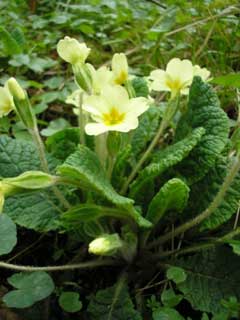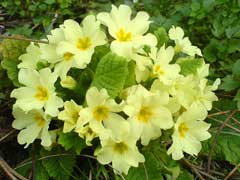 |
|
http://commons.wikimedia.org/wiki/User:Fornax |
 |
| http://commons.wikimedia.org/wiki/User:Pokrajac |
Translate this page:
Summary
Bloom Color: Lavender, Orange, Pink, Purple, Red, White, Yellow. Main Bloom Time: Early spring, Mid spring. Form: Rounded.
Physical Characteristics

 Primula_vulgaris is a PERENNIAL growing to 0.3 m (1ft) by 0.3 m (1ft in) at a medium rate.
Primula_vulgaris is a PERENNIAL growing to 0.3 m (1ft) by 0.3 m (1ft in) at a medium rate.
See above for USDA hardiness. It is hardy to UK zone 6 and is not frost tender. It is in flower from December to May, and the seeds ripen from April to August. The species is hermaphrodite (has both male and female organs) and is pollinated by Bees, Lepidoptera (Moths & Butterflies). The plant is self-fertile.
Suitable for: light (sandy), medium (loamy) and heavy (clay) soils and can grow in heavy clay soil. Suitable pH: mildly acid, neutral and basic (mildly alkaline) soils. It can grow in semi-shade (light woodland) or no shade. It prefers moist soil. The plant can tolerate maritime exposure.
UK Hardiness Map
US Hardiness Map
Synonyms
P. acaulis.
Plant Habitats
Edible Uses
Young leaves - raw or cooked as a potherb, added to soups etc[2, 177, 183]. A mild flavour, though the texture is a bit tough[K]. The leaves are often available all through the winter[K]. Flowers - raw or cooked. They make an attractive garnish to salads[4, 183, 238, K], and can also be used as a cooked vegetable or in conserves etc[4, 183]. Picked when first opened, the flowers are fermented with water and sugar to make a very pleasant and intoxicating wine[2]. Both the flowers and the leaves can be made into a syrup or a tea[183].
References More on Edible Uses
Medicinal Uses
Plants For A Future can not take any responsibility for any adverse effects from the use of plants. Always seek advice from a professional before using a plant medicinally.
Primroses have a very long history of medicinal use and has been particularly employed in treating conditions involving spasms, cramps, paralysis and rheumatic pains[238]. They are, however, considered to be less effective than the related P. veris[238]. The plant contains saponins, which have an expectorant effect, and salicylates which are the main ingredient of aspirin and have anodyne, anti-inflammatory and febrifuge effects[238]. This remedy should not be prescribed for pregnant women, patients who are sensitive to aspirin, or those taking anti-coagulant drugs such as warfarin[238]. The roots and the flowering herb are anodyne, antispasmodic, astringent, emetic, sedative and vermifuge[4]. An infusion of the roots is a good remedy against nervous headaches[4]. The roots are harvested in the autumn when two or three years old and dried for later use[4]. An ointment has been made from the plant and used for treating skin wounds[244].
References More on Medicinal Uses
The Bookshop: Edible Plant Books
Our Latest books on Perennial Plants For Food Forests and Permaculture Gardens in paperback or digital formats.

Edible Tropical Plants
Food Forest Plants for Hotter Conditions: 250+ Plants For Tropical Food Forests & Permaculture Gardens.
More

Edible Temperate Plants
Plants for Your Food Forest: 500 Plants for Temperate Food Forests & Permaculture Gardens.
More

More Books
PFAF have eight books available in paperback and digital formats. Browse the shop for more information.
Shop Now
Other Uses
Makes a good carpet in open woodland and on woodland edges[24, 31]. Plants are best spaced about 35cm apart each way[208]. Attractive flowers.
Special Uses
References More on Other Uses
Cultivation details
Landscape Uses:Container, Ground cover, Rock garden, Woodland garden. Prefers a medium to heavy moisture retentive humus rich loam in a cool position with light to medium shade[200]. Grows well in heavy clay soils. Plants are hardy to about -25°c[187]. A very ornamental plant, there are many named varieties[187]. The blooms have a characteristic fragrance of a mossy bank or a deciduous woodland[245]. This species hybridizes readily with P. elatior[17]. Special Features:
Attractive foliage, Edible, Fragrant foliage, Not North American native, Naturalizing, Suitable for dried flowers, Fragrant flowers.
References Carbon Farming Information and Carbon Sequestration Information
Temperature Converter
Type a value in the Celsius field to convert the value to Fahrenheit:
Fahrenheit:
The PFAF Bookshop
Plants For A Future have a number of books available in paperback and digital form. Book titles include Edible Plants, Edible Perennials, Edible Trees,Edible Shrubs, Woodland Gardening, and Temperate Food Forest Plants. Our new book is Food Forest Plants For Hotter Conditions (Tropical and Sub-Tropical).
Shop Now
Plant Propagation
Seed - best sown as soon as it is ripe in a cold frame[133]. Sow stored seed in early spring in a cold frame[1]. Germination is inhibited by temperatures above 20°c[200]. When they are large enough to handle, prick the seedlings out into individual pots and plant them out in the summer. Division in autumn. This is best done every other year[200].
Other Names
If available other names are mentioned here
Native Range
TEMPERATE ASIA: Cyprus, Iran (north), Lebanon, Syria, Turkey (s.w. & n.), Russian Federation-Ciscaucasia (Ciscaucasia), Armenia, Azerbaijan, Georgia EUROPE: Denmark, Faroe Islands, United Kingdom, Ireland, Norway (south), Austria, Belgium, Switzerland, Czech Republic, Germany, Hungary, Netherlands, Slovakia, Estonia, Ukraine (s.w. & Krym), Albania, Bulgaria, Greece (incl. Crete), Croatia, Italy (incl. Sicily), North Macedonia, Romania, Serbia, Slovenia, Spain, France (incl. Corsica), Portugal AFRICA: Algeria (north), Morocco
Weed Potential
Right plant wrong place. We are currently updating this section.
Please note that a plant may be invasive in one area but may not in your area so it's worth checking.
Conservation Status
IUCN Red List of Threatened Plants Status :

Growth: S = slow M = medium F = fast. Soil: L = light (sandy) M = medium H = heavy (clay). pH: A = acid N = neutral B = basic (alkaline). Shade: F = full shade S = semi-shade N = no shade. Moisture: D = dry M = Moist We = wet Wa = water.
Now available:
Food Forest Plants for Mediterranean Conditions
350+ Perennial Plants For Mediterranean and Drier Food Forests and Permaculture Gardens.
[Paperback and eBook]
This is the third in Plants For A Future's series of plant guides for food forests tailored to
specific climate zones. Following volumes on temperate and tropical ecosystems, this book focuses
on species suited to Mediterranean conditions—regions with hot, dry summers and cool, wet winters,
often facing the added challenge of climate change.
Read More
Expert comment
Author
Huds.
Botanical References
17200
Links / References
For a list of references used on this page please go here
Readers comment